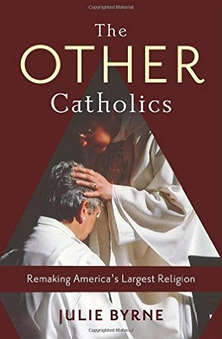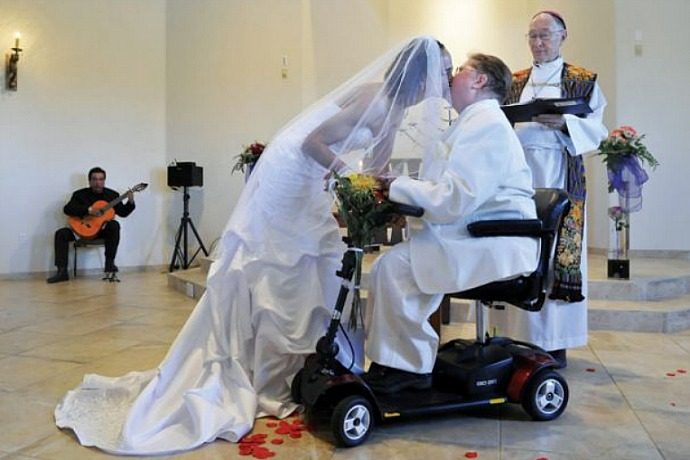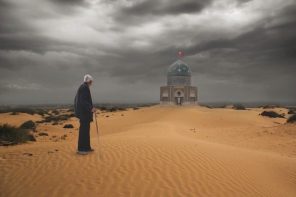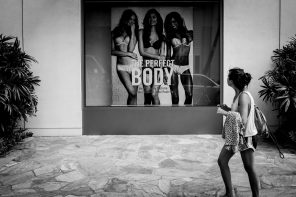In this RD10Q, Julie Byrne follows the emerging movement of independent Catholics and the justice they inspire.
What inspired you to write The Other Catholics?
I was inspired by meeting independent Catholics!
At first I was aware of the existence of only one independent Catholic church, the Imani Temple in Washington, D.C. And I only knew of the Imani Temple because way back in 1988, when I was an undergraduate at Duke, I attended a mass celebrated by Father George Stallings, who was then a radical priest within the Roman church.

The Other Catholics: Remaking America’s Largest Religion
Julie Byrne
Columbia University Press
May 2016
It was a rousing African-accented mass with drums and libation for the ancestors, and I thought Stallings was the second coming of Jesus for the Roman church. A year later, he left Rome and founded the Imani Temple, to continue a mission that was not only anti-racist and Afrocentric, but also embraced open communion, married clergy, women’s ordination, out-LGBTIQ ordination, and a host of other reforms.
Shortly after its founding, the Imani Temple welcomed an “Old Catholic” bishop from California to consecrate Stallings to the episcopate, so that Stallings could ordain priests and sustain the movement. So after my first book was finished, I started hanging out at Stallings’ C Street cathedral. I slowly realized that independent Catholicism included not only the Imani Temple and the “Old Catholic” California bishop, but literally hundreds of small jurisdictions all over the U.S. and the world. Many of them were witnessing Catholic tradition and also experimenting with it in ways I could never have imagined. And yet I’d gone through an entire Roman Catholic upbringing and doctoral education in Catholic Studies and heard nothing about them.
Well, to be accurate, I’d heard of the Polish National Catholic Church, but only as an exception. It turns out that breakaway Catholicism was, on the contrary, rather common?! I was totally seized with the imperative to write the book.
What’s the most important take-home message for readers?
Independent Catholic churches are small, so they don’t have a big social justice footprint. They don’t have money to run a big operation like Catholic Charities or rent buses for climate marches. But precisely because they are small, they are absolutely brilliant at what I call “sacramental justice.”
If social justice is working for a society of equals, “sacramental justice” is opening the sacraments to all. Independents celebrate the traditional seven sacraments of Catholicism, but without formal connection to the pope in Rome. They make decisions as free-standing communities and “just do it.”
A woman called to the priesthood can get ordained. Divorced-and-remarried people can take communion. A Catholic and Buddhist couple can have a sacramental marriage. A lesbian couple can have their baby baptized.
Independents do this “sacramental justice” work every day—and not just within their own churches. In fact, independent Catholic priests often serve Roman Catholics who cannot get the sacraments otherwise. It might be a single mom who cannot take time off from work to take her child to two years’ worth of Saturday confirmation preparation classes. Or a couple who wants to get married on the beach, whereas the Roman church requires sacramental marriage to be performed in a Roman sanctuary. Or a funeral for a favorite uncle who married a man. Roman parishioners who run into these roadblocks might hear about independent Catholic priests by word of mouth or just find them on Google. Even if they are back in their Roman parish the next weekend—and they usually are—still there has been that contact and interchange with independent Catholicism at a critical and intimate life moment.
There is even an underground network of cooperation between priests of Roman and independent Catholic bodies. Numerous independent priests report that they occasionally get calls from Roman priest-friends who know they can’t legally do a sacrament, so they refer a parishioner to their independent buddy. When you see this porousness between independents and the Roman church, modern Catholicism starts to look like a whole cluster of interacting bodies rather than one singular institution. You start to suspect that independent Catholic “sacramental justice” activism is actually part of how modern Catholicism works.
Is there anything you had to leave out?
I made the decision to focus on one particular independent Catholic jurisdiction and its amazing people. That would be the Church of Antioch and, as the book ended, a sister group called the Ascension Alliance.
The Church of Antioch was founded in 1957, precociously ordained women in 1974, and had archives, so I felt I could tell a rich story about its particular journey while also effectively sketching the big picture of U.S. independent Catholicism. However, that means I left out richness and depth about all the other fascinating independent Catholics I met. I wish I could have told many more stories!
But I know other scholars are already taking up this task. Elizabeth Pritchard at Bowdoin is working on a book about The Old Catholic Church USA. Jill Peterfeso at Guilford will soon publish a book on Roman Catholic women priests. Alexis Tancibok in the U.K. is doing much-needed historical work on the “godfather of U.S. independent Catholicism,” Joseph René Vilatte. Matthew Butler at the University of Texas at Austin is writing about Father Pérez, the leader of a revolution-era independent Mexican Catholic church. There are yet dozens more dissertations and books to be written, and I can’t wait to read them!
What is the biggest misconception about your topic?
Because the Roman church is by far the biggest Catholic jurisdiction and because it has vast public presence and power, most people in the U.S.—not just Roman Catholics—equate “Catholicism” and “Roman Catholicism,” end of story. It’s been a long struggle of independent Catholics—a struggle that I now share—to get people to even process the words “independent Catholicism.” Huh, is that a thing? So it takes a good quick explanation. Even then the reaction might be, “How can you be Catholic without the pope?,” or “That’s not real Catholicism,” or “That’s Protestantism.”
I would love it if readers, including conceptual gatekeepers like journalists and teachers and scholars, could come away seeing that the automatic equation of Catholicism with Roman Catholicism is actually a specifically Roman theological position. That’s fine for Roman Catholic confessional contexts, but it is not really appropriate for general public usage. In secular classrooms or in the media, we should try to remember to use modifiers to specify which Catholicism we’re talking about: the Roman Catholic church, an Old Catholic church, this Anglo-Catholic parish, that canonical Orthodox congregation.
Did you have a specific audience in mind when writing?
I wrote it for everyone—! I hope it’s a highly readable book that happens to have all the scholarly apparatus, too. There are endnotes and—online at Columbia’s web page for the book—a full bibliography and bibliographic essay.
Are you hoping to just inform readers? Entertain them? Piss them off?
I have heard from people who said they were reading the book and laughing out loud, so apparently it has moments of humor or at least delight. I assume that some readers will feel suspicious, disturbed or angry. Independent Catholicism is a very new concept for most people, and it will provoke the gamut of reactions.
What alternative title would you give the book?
I really wish I’d thought to put “sacramental justice” in the subtitle. Ah, well.
How do you feel about the cover?
Love it. The photo captures quite a glowy moment in the diaconal ordination of JoEllen Werthman by Bishop Kera Hamilton, both of Philadelphia. Over the ten years of writing this book, they have become dear friends. I call them “my” “cover girls.”
Is there a book out there you wish you had written? Which one? Why?
I am still a huge fan of Karen McCarthy Brown’s Mama Lola, and of Mark D. Jordan’s The Silence of Sodom. Both books took huge risks of form and authorial disclosure. Both are beautifully written and devastatingly exact. Both are still one-of-a-kind.
What’s your next book?
I live in Brooklyn and teach on Long Island, so this time I’m staying local. It’s “a 9/11 book,” focused on tri-state Roman Catholics’ experience of that event. But I also hope to tell a larger story about U.S. Roman Catholic masculinity, mourning, upward mobility and whiteness.
Another way of saying this is that I want to explore how suburban Roman Catholics became, in our present moment, a significantly Trumpish demographic. I am not sure I will like what I find, but it’s clearly part of understanding contemporary Catholicism. And I know I will be surprised. Talking to people about their lives and loves, one is always surprised.





